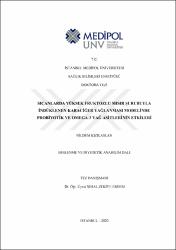| dc.contributor.advisor | Erdem, Nihal Zekiye | |
| dc.contributor.author | Kızılaslan, Nildem | |
| dc.date.accessioned | 2021-08-23T08:51:45Z | |
| dc.date.available | 2021-08-23T08:51:45Z | |
| dc.date.issued | 2020 | en_US |
| dc.date.submitted | 2020-06-25 | |
| dc.identifier.citation | Kızılaslan, N. (2020). Sıçanlarda yüksek fruktozlu mısır şurubuyla indüklenen karaciğer yağlanması modelinde probiyotik ve omega-3 yağ asitlerinin etkileri. (Yayınlanmamış doktora tezi). İstanbul Medipol Üniversitesi Sağlık Bilimleri Enstitüsü, İstanbul. | en_US |
| dc.identifier.uri | https://hdl.handle.net/20.500.12511/7920 | |
| dc.description.abstract | Non alkolik yağlı karaciğer hastalığı, patogenezi tam olarak anlaşılamayan, kompleks ve multifaktöriyel bir hastalıktır. Bu çalışmada, yüksek fruktozlu mısır şurubuyla (YFMŞ) karaciğer yağlanması modeli oluşturulan sıçanlarda probiyotik ve omega-3 yağ asitlerinin etkilerinin ortaya konulması amaçlanmıştır. Çalışmada 40 adet Wistar Albino cinsi erkek sıçanlar kullanılmış ve 5 gruba ayrılmıştır. Üç hafta boyunca YFMŞ dört grubun (2.Grup, 3.Grup, 4.Grup, 5.Grup) içme suyuna (%30'luk çözelti) olacak şekilde eklenmiştir ve ad libitium beslenmişlerdir. Üç haftanın sonunda 3.grup, 4. grup ve 5. gruptaki omega-3 yağ asiti (400 mg/kg) ve probiyotik (1,5x10⁹ kob/mL/gün) gavaj yöntemiyle 4 hafta boyunca verilmiştir. Bu süre sonunda, sıçanlardan kan örnekleri ve dokular alınıp sakrifiye edilmiştir. Bu çalışmada, YFMŞ grubuna göre YFMŞ+Omega-3 yağ asiti, YFMŞ+Probiyotik ve YFMŞ+Omega-3 yağ asiti+Probiyotik gruplarında kesim ağırlığı değişimi daha düşük bulunmuş olup arasındaki fark istatistiksel olarak önemlidir. Deney gruplarının ortalama serum düzeyleri arasındaki fark istatistiksel açıdan önemli bulunmuştur. En yüksek glukoz, ALT, ALP, serum kolesterol, trigliserid, AST, doku TNF-α, IL-6 düzeyi YFMŞ grubunda belirlenmiştir. En yüksek doku GSH ve MDA düzeyi YFMŞ+Omega-3 yağ asiti grubunda görülmüştür. En düşük ortalama steatoz düzeyinin kontrol grubunda, en yüksek ise YFMŞ grubunda olduğu belirlenmiştir. Kontrol grubunda lobular inflamasyon görülmezken, en yüksek düzey YFMŞ grubunda bulunmuştur. Sonuç olarak, YFMŞ ile oluşturulan karaciğer yağlanması modelinde probiyotik ve omega-3 yağ asiti desteğinin koruyucu etkisi histopatolojik ve biyokimyasal olarak gösterilmiştir. Omega-3 yağ asiti ve probiyotik desteğinin hastalığın remisyonu için alternatif bir yaklaşım olabileceği düşünülmektedir. Ancak rutin uygulanacak bir protokol oluşturulabilmesi için daha fazla çalışmaya gereksinim duyulmaktadır. | en_US |
| dc.description.abstract | Non-alcoholic fatty liver disease is a complex and multifactorial disease whose pathogenesis is not completely understood. This study aimed to investigate the effects of probiotics and omega-3 fatty acids in rats on which a liver steatosis model was established by high-fructose corn syrup (HFCS). The study included 40 male Wistar Albino rats divided into 5 groups. For three weeks, HFCS was added to the drinking water of four groups (Groups 2, 3, 4 and 5) (as a 30% solution), and the rats were fed ad libitum. At the end of the three weeks, in Groups 3, 4 and 5, omega-3 fatty acids (400 mg/kg) and probiotics (1.5x10⁹ cfu/mL/day) were given for 4 weeks by the gavage method. At the end of this period, blood and tissue samples were collected from the rats, and the rats were sacrificed. The change in the slaughter weight in comparison to the HFCS group was found to be significantly lower in the HFCS + Omega-3 fatty acid, HFCS + Probiotics and HFCS + Omega-3 fatty acid + Probiotics groups. The differences between the mean serum levels of the experiment groups were statistically significant. The highest glucose, ALT, ALP, serum cholesterol, triglyceride, AST, tissue TNF-α and IL-6 levels were found in the HFCS group. The highest tissue GSH and MDA levels were found in the HFCS+Omega-3 fatty acid group. The lowest mean steatosis level was in the control group, while the highest one was in the HFCS group. While there was no lobular inflammation in the control group, the highest level was observed in the HFCS group. Consequently, the protective effect of probiotics and omega-3 fatty acid support in HFCS-induced liver steatosis model was demonstrated histopathologically and biochemically. It is considered that omega-3 fatty acid and probiotics support may be an alternative approach for the remission of the disease. However, to be able to establish a protocol to be routinely applied, more studies are needed. | en_US |
| dc.language.iso | tur | en_US |
| dc.publisher | İstanbul Medipol Üniversitesi Sağlık Bilimleri Enstitüsü | en_US |
| dc.rights | info:eu-repo/semantics/openAccess | en_US |
| dc.subject | Beslenme | en_US |
| dc.subject | Non Alkolik Yağlı Karaciğer Hastalığı | en_US |
| dc.subject | Omega-3 Yağ Asitleri | en_US |
| dc.subject | Probiyotik | en_US |
| dc.subject | Yüksek Fruktozlu Mısır Şurubu | en_US |
| dc.subject | Nutrition | en_US |
| dc.subject | Non-Alcoholic Fatty Liver Disease | en_US |
| dc.subject | Omega-3 Fatty Acid | en_US |
| dc.subject | Probiotics | en_US |
| dc.subject | High-Fructose Corn Syrup | en_US |
| dc.title | Sıçanlarda yüksek fruktozlu mısır şurubuyla indüklenen karaciğer yağlanması modelinde probiyotik ve omega-3 yağ asitlerinin etkileri | en_US |
| dc.title.alternative | The effects of probiotic and omega-3 fatty acids in a model of high-fructose corn syrup-inducefattyd liver in rats | en_US |
| dc.type | doctoralThesis | en_US |
| dc.department | İstanbul Medipol Üniversitesi, Sağlık Bilimleri Enstitüsü, Beslenme ve Diyetetik Ana Bilim Dalı | en_US |
| dc.relation.publicationcategory | Tez | en_US |


















